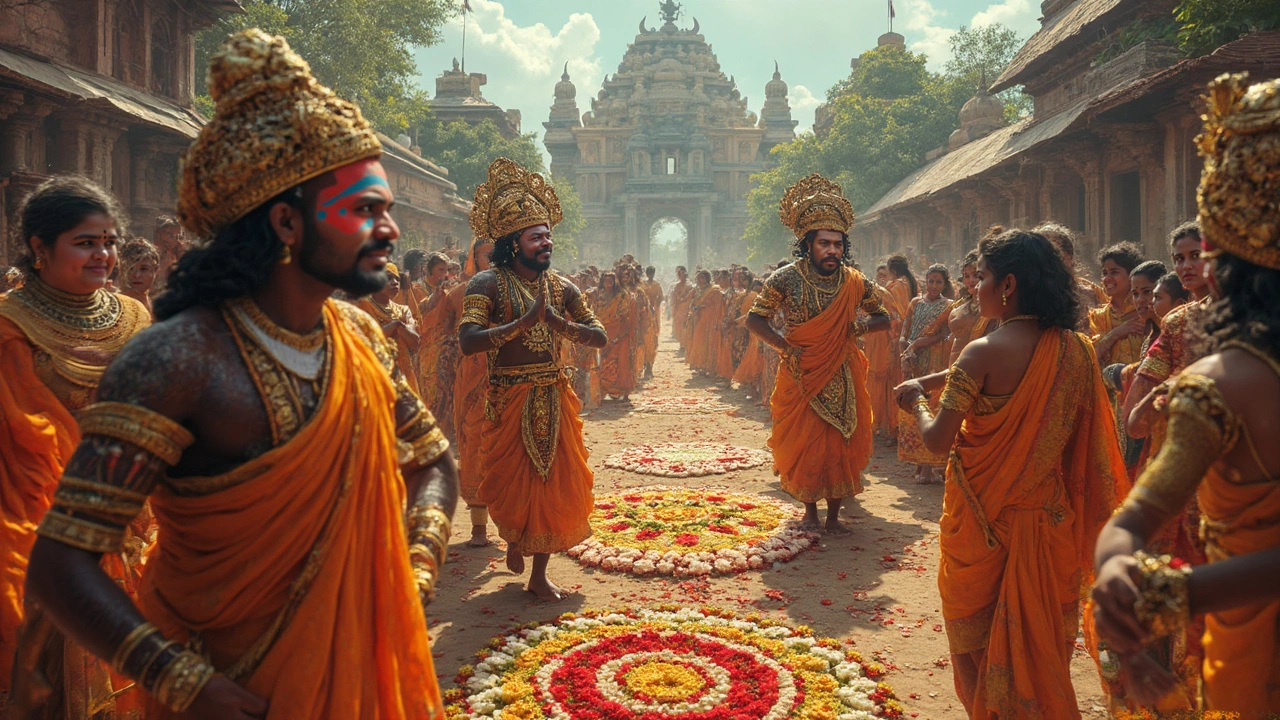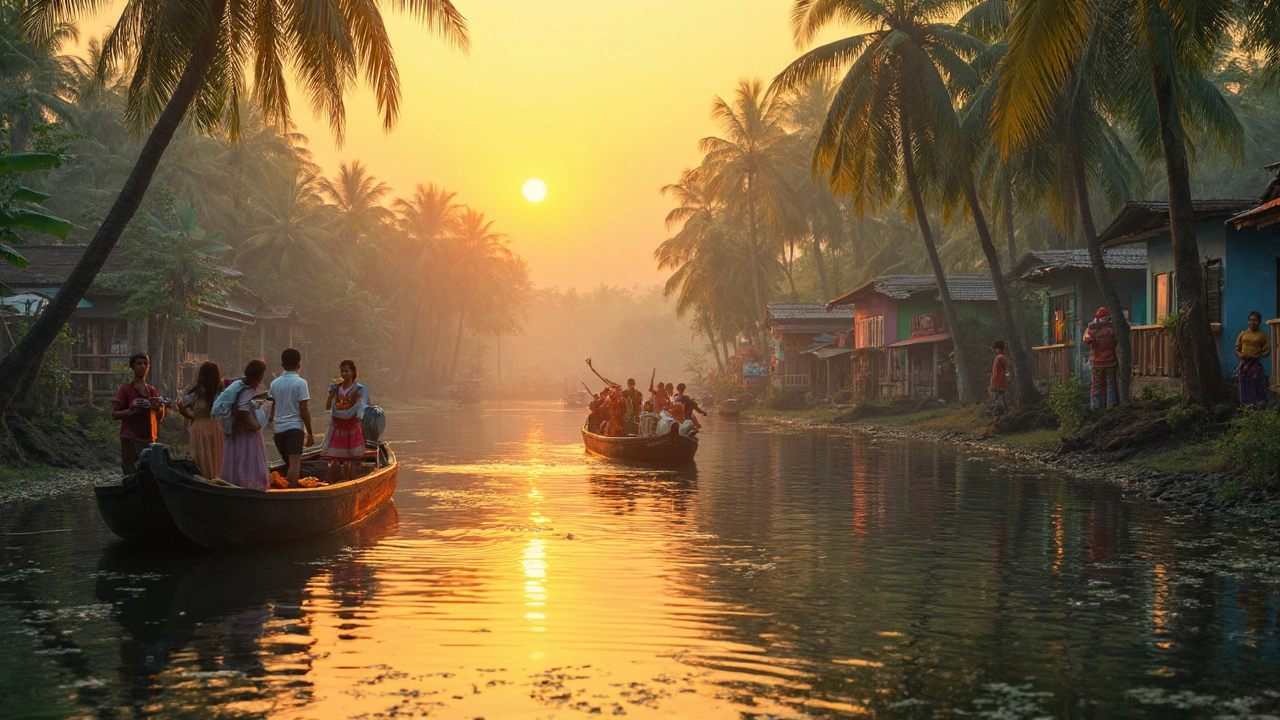Imagine a place in India where coconut trees reach for the sky and emerald rivers lazily wind through sleepy villages. Then imagine this region scoring the highest in literacy, boasting top-tier healthcare, and hosting a blend of festivals and lifestyles you just don’t see anywhere else—in India or abroad. Kerala isn’t just a state; it’s practically a country within a country, and locals will nod along with this idea. If you’re ever stuck on a trivia show with the question “What’s so different about Kerala?”—grab your buzzer, because there’s a feast of answers.
A Social Fabric Like No Other
Start with Kerala’s people. Around 35 million residents live there, according to India's 2021 census. What grabs your attention straight away is the literacy rate: a whopping 96.2%, the highest of any Indian state. You’ll spot it in the way people speak English confidently or eagerly introduce you to Malayalam poetry and writers. While I was in Kerala, even a fisherman I chatted with on Varkala beach quoted Tagore as if he was just talking about the weather. Nowhere else in India do you find public libraries buzzing and bookstores thriving in small towns. The focus on education isn’t a recent thing, either. For decades, Kerala’s governments (whether left or right) poured resources into near-universal schooling, and it’s paid off.
But it’s not just literacy. Kerala shows off social development stats that would make many wealthy Asian or Western countries blush. Infant mortality is super low: just 6 deaths per 1,000 live births, compared to the national average of 28. Hospitals use electronic records, nurses run outreach programs, and even the smallest clinics are clean and organized. If you’re taking the kids or elderly family along, you notice these differences immediately. Compare this with chaotic scenes at clinics elsewhere, and Kerala feels almost Nordic. No wonder, in 2022, National Family Health Survey data put Kerala at the top for health outcomes, female literacy, and life expectancy (over 75 years!).
Women aren’t just educated—they’re empowered. Kerala’s matrilineal traditions linger, especially among Nairs and some Christian communities. Girls get the same inheritance rights as boys. Women fill classrooms, run businesses, and dominate the teaching force. In politics and grassroots organisations, they’re just as visible as men. Walk through a market, see women selling fish, handloom, or running tourism agencies. This is miles ahead of the national average, where gender roles are slowly evolving but aren’t quite as flexible.
If you want to dig into the numbers, here’s a quick table for comparison:
| Metric | Kerala | Indian Average |
|---|---|---|
| Literacy Rate | 96.2% | 77.7% |
| Infant Mortality Rate (per 1,000 live births) | 6 | 28 |
| Life Expectancy | 75+ years | 69.8 years |
| Sex Ratio (Females per 1000 Males) | 1084 | 943 |
Blending Religion, Festivals, and Daily Harmony
Most Indian states have areas where different faiths mix, but Kerala is a poster child for true religious diversity—and peace. Walk down a Kochi street, and you’ll hear church bells, a mosque’s call to prayer, and temple bells all mingling. About 55% of the population is Hindu, 27% Muslim, and roughly 18% Christian. I had a chance to visit during Onam, Kerala’s state festival, and saw Muslims and Christians pitching in for flower displays (pookalam) alongside Hindus. When Christmas comes, Hindu shopkeepers hand out sweets to Christian customers. It’s baked right into the culture—a norm, not an exception.
The festivals themselves are something to witness. Where else do you get boat races so intense that locals treat them like a football derby? The Nehru Trophy Boat Race is a riot of color, crowds, and euphoria. Then there’s Thrissur Pooram, where elephants in glittering regalia line up in a procession, fireworks light up the night, and musicians set a rhythm you feel in your bones. The energy is infectious; even tourists from Europe end up grooving with locals. Kerala’s churches fill up during Easter, and mosques buzz during Eid, but the lines between faiths blur during celebrations. Kids grow up around each other’s holidays, making the whole thing feel like one big, rolling party. It stands out even if you’ve traveled widely in India—few places offer such hassle-free coexistence.
Cuisine is a story, too. From beef fry to appam and stew, or fish cooked in coconut milk, it’s hard to find food taboos. You’ll find halal, vegetarian Sadhya feasts, and pork vindaloo (Christian households) all on the same street. In most cities here, dinner parties cut across religions, adding to the sense of shared identities. Even street food, like banana chips and hot pazham pori (banana fritters), welcomes everyone. Kerala’s dining tables could put most multicultural fusion restaurants to shame.

Outstanding Nature, Backwaters, and Daily Life
Kerala’s geography feels somehow out of sync with the rest of India. The Western Ghats (UNESCO-listed, by the way) snake down the backbone of the state, feeding dozens of emerald rivers and hiding wildlife not found anywhere else. Ever heard a school let out at 3pm, only for kids to hop onto small wooden canoes tossed by their parents? That’s how some children in Alleppey get home. The state’s backwaters—1,500+ km of interconnected canals, rivers, and lagoons—literally shape daily life. The famous Kettuvallam houseboats floating by are no tourist trap; locals use canoes and ferries for work, weddings, even pizza deliveries.
Step into the highlands around Munnar or Wayanad, and you’ll wonder if you’re still in India. Rolling tea plantations, cool breezes, and elephants munching quietly in the distance. In the mornings, markets burst open with jackfruit, tapioca, and piles of green leafy parotta. Beachside? Kovalam and Varkala offer sunsets with volleyball games, chai stalls, and fishing boats in the distance. It’s not uncommon to spot yoga classes on the sand while hawkers sell spicy mango slices.
Conservation efforts are huge. The Silent Valley National Park, for example, protects a rainforest untouched for centuries. Even the highways seem to respect the environment—many are shaded by thick greenery, which makes driving a pleasure (if a little twisty). Kerala runs one of the strictest plastic bans in India. Tourists get asked to carry steel water bottles, and local vendors use banana leaves to wrap snacks. At home, many families compost or use biogas plants. It’s this practical environmentalism that’s now earning Kerala recognition. For travelers passionate about eco-friendly holidays, it’s a haven.
If you’re heading there, remember: monsoons are wild—intensely beautiful but relentless. Pack a good umbrella, quick-drying clothes, and waterproof shoes. Buses and trains fill up fast in the rain. If you’re tasting local fruit, the best stuff—like chakka (jackfruit) and mangosteen—hits markets between May and September. Bird-watchers and hikers should go from November to February, when it’s cool and clear.
The Malayali Identity: Pride, Diaspora, and a Worldview
Here’s a quirky fact: more Keralites (Malayalis) live outside Kerala than in. The Gulf migration is legendary. In places like Dubai or Muscat, you’ll hear Malayalam in supermarkets and see entire neighborhoods built by Kerala’s remittances. This has changed the face of Kerala back home. You’ll spot beautifully tiled mansions (called Gulf houses) in tiny villages, satellite dishes everywhere, and families WhatsApping relatives overseas every day. Remittances from the diaspora bring in an average of $15 billion USD a year, propping up local economies and funding education, healthcare, and even festivals.
Lifestyles have adapted. Families eat late dinners—often after chatting with cousins in Canada or uncles in Kuwait. Young people travel globally, picking up trends, music, and tech, but return home and dive into temple festivals or football with the same gusto. Kerala’s young generation has one foot in the world, another deeply rooted in home soil. The embrace of outside ideas is strong—so are ancient traditions. Ayurveda, for example, is a living science, not a tourist fad. Locals use Ayurvedic oils for everyday bruises, colds, or wellness routines. Even my mate Ansel got a herbal massage on a family trip, and swears it cured his ‘cranky back’ better than anything modern medicine threw at him!
The Malayali sense of humor is sharp, self-deprecating, and alive on social media. Memes, viral videos, and political satire circulate daily—whether it’s about cricket losses, politics, or the latest movie flop. Love for cinema runs deep. Malayalam films (Mollywood) push boundaries far more than Bollywood, digging into gritty issues with honesty. The 2019 film “Kumbalangi Nights,” for instance, explored masculinity and family in ways rarely seen elsewhere in India. The pride folks take in these achievements shines through, both at home and across their global communities.
Keralites travel—often. With one of India’s highest rates of passport holders, nearly every family has a member working abroad or planning a long trip. The result? You get locals who can talk geopolitics with taxi drivers in London, then return home and debate coconut prices with fishermen. You see this in Kerala’s openness: debates, books, new ideas, and a love for the next big thing—tempered by an equally strong love for tradition. If you have a Malayali neighbor, try asking about their favorite local poet or film—get ready for a passionate, maybe lengthy, chat.
If you’re a parent, Kerala’s family-friendliness stands out. Clean beaches have play areas and lifeguards, museums cater to kids, and nearly every town has clean public parks. You’ll spot families (with kids and dogs!) picnicking together—which, speaking from a dad’s perspective, is a big plus. And just in case you’re wondering: yes, I did meet a few pugs and golden retrievers who were living pretty good beach lives in Kerala.
So, what really makes Kerala different? It’s this mix of quality-of-life indicators, deep-rooted traditions, adaptation to the modern world, and an easygoing, inclusive vibe. If you ever get the chance, walk the length of Fort Kochi at dawn, catch breakfast at a bustling bus stand canteen, or float down the backwaters at sunset with banana fritters in hand… Then you’ll see: Kerala’s difference isn’t just in statistics or slogans—it’s in the air you breathe, the stories you hear, and, honestly, the smile you carry after leaving the place.
